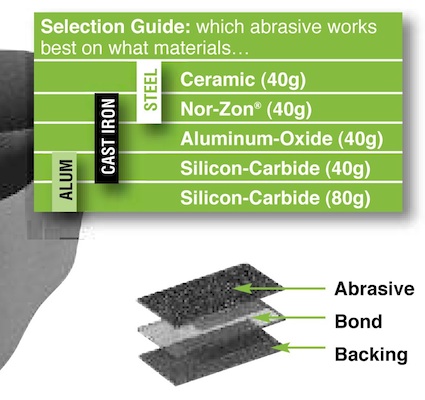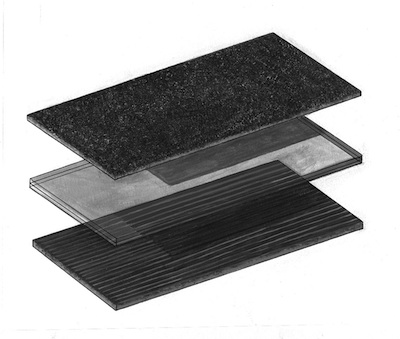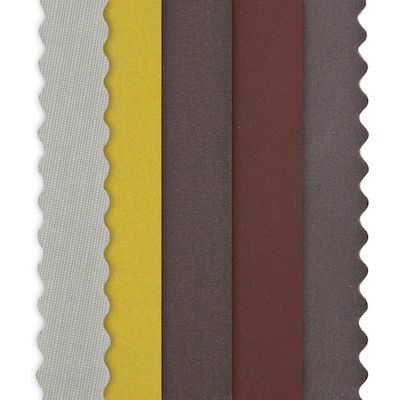Conventional abrasives have kind of taken a back seat to PCD and CBN cutters in the automotive world in the last few years. Since most engines being rebuilt these days are made from multi-alloy components they are more easily machined with PCD or CBN. But PCD and CBN can’t do everything, so abrasives are still needed in today’s professional machine shops.
The diesel market still depends heavily on abrasives due to the hardness of the iron and steel components being used in diesel power plants. Abrasives are still widely used for surface finishing, porting and polishing, cylinder honing, crankshaft grinding and polishing, flywheel grinding and more.
Before getting into the specific applications, there are some things that you must keep in mind for all abrasives. I call these the “Abrasives ABCs.”
• Appropriate Abrasive – Match the abrasive to the material you are working on. Some, or should I say most, companies ask that you select one abrasive that is supposed to be the “Grand Poobah” of material to grind anything and everything. Let me tell you that is certainly not the case at all. If you’re working on a hard material, you want a softer abrasive. Be sure to match your abrasive to the type of material, for example, if you’re machining nickel-chrome valve seats, you’ll want an abrasive designed to cut nickel-chrome.
• Best Condition – Make sure your grinding equipment is in great shape by having a sharp and pointed dressing diamond or star dresser at your disposal.
• Clean Coolant – Make sure you have clean grinding coolant for those applications that require it. Old, dirty coolant will make the stone work harder and won’t flush the debris away as efficiently.
Okay, let’s take a look at some specific applications (and be sure to apply these guidelines to the supplement in this month’s Engine Builder).
Valve Grinding
Here is where we have never quit using a traditional type of abrasive. A valve should be ground, and to grind a valve properly we need to match our abrasive to the type of material we are grinding. Valves have changed a lot over the years and we will have materials very different from what we use to grind back in the day. Today, we have stainless steel, titanium, Inconel, stellite and of course standard iron and steel.
By incorporating the “Abrasive ABCs” into your grinding procedure you have the best chance to grind the material without stone load and the finish will be what you require for the application. Keep in mind some valves have a special coating that prevents you from grinding at all. Pay close attention if you see any cautions and/or notes from the manufacturer to ensure you don’t grind away the coating.
Seat Grinding
Here again, the valve seat has evolved and of course the machine manufacturers have also evolved. Many shops have already migrated to using the multi-angle carbide cutters that cut multiple angles simultaneously.
However, in my travels around this great country of ours, I still see a lot of seat grinding going on. Valve seats come in a variety of materials. Nickel chrome, Stellite, cast iron, copper-beryllium, and powdered metal. You simply cannot expect one grinding spec to grind all of these different materials.
Surface Grinding
We still see a lot of abrasives being used here as well. While many shops have acquired the newer cutting machines that use CBN and PCD and some of you have converted your existing grinding machines to also use the CBN or PCD, there are some applications that simply need to be ground. Diesel cylinder heads and aluminum cylinder heads, both with exposed valve seats or pre-cups, are two examples.
Segmented abrasives for surface grinders generally come in three different specs: silicon-carbide abrasive for cast iron and aluminum; aluminum oxide abrasive for steel and hardened metals; and aluminum oxide and silicon-carbide combination abrasive for aluminum, cast iron, hardened iron and steel.
Surfacing Belts
This is still a very popular method for a quick clean up on the surface or even a final surface for some applications, especially with exhaust manifolds. The beauty of a belt surface is there is little to no set up. However, you still have to match the abrasives as well as grit to the material you are grinding.
Make sure the belt you use has a waterproof, poly back so it won’t tear or fray during the surfacing operation. Some of these types of belts require a lot of down pressure and others don’t. Here are some guidelines:
• Silicon-carbide 40 grit is generally used for cast iron.
• Silicon-Carbide 80 grit is for aluminum.
• Ceramic 40 grit is for cast iron and steel and down pressure is required.
• Nor-Zon 40 grit for cast iron and steel but this needs a lot of down pressure and most machines running this belt would have an air or hydraulic hold down system incorporated into its design.
• Aluminum oxide 40 grit is standard on most machines and works with little down pressure.
Porting and Polishing
I know you can buy CNC ported cylinder heads but you might be very surprised just how many shops still do it by hand. The little abrasive cartridge rolls (or “Tootsie rolls” as they are called) used for hand porting need to be of the highest quality you can find. They are not all the same. The good ones are fully glued to prevent them from un-rolling during use. Some key things to remember when porting and polishing are:
1. Use a porting a polishing fluid to improve the finish and prolong the cartridge roll.
2. Never use squashed or reformed cartridge rolls as they may become shrapnel when spun.
3. Never use a bent mandrel as this will cause vibration and reduce your ability to control the abrasive while in use.
4. Always wear safety glasses when doing this type of work.
Cylinder Honing
Hundreds, maybe even thousands of articles have been written about cylinder honing by people smarter than me. I’ll leave the details to the experts, but I will highlight some general things we all need to know.
Honing stones are designed for specific materials, for specific ranges of size and for specific types of honing, such as manual honing vs. machine honing. Grits range from around 70 grit up 600 grit for most automotive applications. Bore ranges are down to about 1.250? and up to 9.00?.
Keep in mind, certain honing stones are for specific types of honing, so match the stone to the material. If you have a hone that has felt wipers then these are designed for dry honing only and are generally used in hand-held drills for very light stock removal.
Traditional vitrified stone sets with aluminum wipers are used in both hand-held drills as well as machines and must be used with a good quality honing oil. Never use tranny fluid or a concoction of “secret oil and solvent” or any other passed-down home recipe, as this will attack most bonding agents that hold the grain together and cause premature failure of the honing stones.
Honing stones, if used properly, will wear consistently. Good quality honing oil will keep stones free cutting and prevent loading up, allowing the stones to do their job. New stones will sometimes need to have the corners radiused to conform to the round cylinder bore, and in the event your stones do become loaded up you can dress them with a diamond file or even use a stone against a stone to assist in unloading the built up material.
In extreme cases of taper, the stones will actually be worn at severe angles. When this happens, you will need to use a truing sleeve to get them trued back up before you can expect any result during the honing process.
Cam Grinding Wheels
Cams are finished ground after they go through the manufacturing process. As you know camshafts are made of both steel and cast iron. Depending on the application, some camshafts are harder than others, even when made from the same material.
Most cam wheels are in the 100 grit range and are available in diameters from 18? to 20? in widths from 3/4? up to about 1-1/2?. Premium wheels for harder material above the 55 Rockwell spec are available and made from a green silicon-carbide and have grit around 70. Cam wheels require a lot of clean coolant and must have a very sharp diamond for periodic dressing to prevent loading and, therefore, burning of the lobe during the grinding process.
Crank Grinding Wheels
These big rascals are the biggest grinding wheels or piece of abrasive used in the engine rebuilding business. They range from 18? in diameter up to 40? in diameter. They come in widths from 3/4? up to 3-1/2?. And, just as with every other abrasive, one wheel cannot be expected to do every job in the automotive or diesel world.
You must match the wheel to the material you are grinding. If you are grinding automotive and the journal is less than 35 Rockwell then a traditional medium grade wheel will do the job. If you are grinding harder diesel or performance crankshafts (over 35 Rockwell) then you need a wheel designed specifically for these types of applications.
Grinding wheels will load up so they need a constant flow of clean, high quality coolant and lots of it. A very sharp diamond is an important player to maintain the proper dress to grind.
Crankshaft Polishing
Polishing belts are just what the name says: they are for polishing – PERIOD! I have seen too many shops attempt to correct a poorly ground crankshaft with polishing belts. If the crank is ground correctly then the polishing belt will do its job and improve the finish as well as remove minute imperfections in the journal surface.
Polishing belts are available in widths from a narrow as 3/4? and as wide as up to 2?. Grits are from 240 grit up to 800 grit. I like to see the use of polishing rouge in the mix to improve the finish to a nice luster. Some key things to remember about crankshaft polishing belts:
1. Scalloped edge belts are for polishing the radii on the crankshaft.
2. Match the width of the belt to the journal width.
3. Use polishing rouge for maximum shine.
4. Chamfer oil holes prior to polishing.
5. Polishing belts are more prone to moisture-damage than wheels. Store belts in a clean, dry area at room temperature. I heard of one shop that keeps them in the refrigerator and says it protects the belts from the humidity.
Flywheel Grinding
There is lots to talk about when it comes to flywheel grinding. Yes, there are general purpose stones that do a pretty good job on most cast iron flywheels. However not all flywheels are made of cast iron; they are also made from cast steel, billet steel as well as aluminum with steel wear inserts.
Flywheels are becoming popular again due to the resurgence of stick-shift cars. Big over-the-road trucks all have clutches and that means flywheel grinding opportunity.
I like to suggest if you are grinding flywheels and don’t know where to start or which wheel is best for what application, to use the middle wheel and go up or down the scale from there. If your supplier only offers one type of wheel to grind all, then find a different supplier.
Always inspect your dresser, especially if it is a star dresser, which must rotate. Diamond dressers need even closer inspection as sometimes the diamond can be knocked off with no warning. If this happens, a flywheel could grenade during dressing. Always, always, always wear eye protection!
Safety First
Grinding wheels and abrasive belts are a part of everyday business in the machine shop. How we handle and store these is the challenge for all of us. Heat, cold and even heavy humidity can wreak havoc on any grinding wheel, and especially on abrasive belts. I have a few final thoughts about abrasives for you:
1. Blotters are not just a great place for your company’s logo. Never mount a grinding wheel without a blotter…ever.
2. Do not over tighten. Tighten just enough to hold wheel firmly.
3. Ring test wheels prior to mounting by knuckle knocking the wheel and listening closely. It should ring like a bell and not like a clunk.
4. Inspect wheel dressers periodically.
5. Ensure wheel safety guards are in place at all times.
6. Never exceed maximum rpm of wheel.
7. Visually inspect each wheel before use. For safety’s sake, if in doubt throw it out. Nobody wants to be a pirate every Halloween.
Treat your grinding wheels and all of your abrasives with care and they will perform the job you need to do when you need to do it.
See ya in the shop!
Dave Monyhan is national sales manager with Goodson Shop Supplies, located in Winona, MN. You can reach Dave at [email protected]. 















